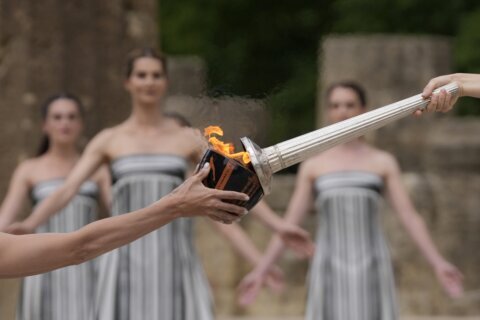ST. PAUL, Minn. (AP) — Prosecutors in the trial of three former Minneapolis police officers charged with violating George Floyd’s civil rights accused the men Monday of standing by as fellow Officer Derek Chauvin “slowly killed George Floyd right in front of them.”
But one defense attorney countered during opening statements of the former officers’ trial that Chauvin called “all of the shots” as the senior officer at the scene and criticized the Minneapolis Police Department for doing too little to train officers to intervene when a colleague should be stopped. Another officer’s attorney focused on Floyd’s struggle with police before they restrained him. And an attorney for the third officer said his client raised concerns about the restraint of Floyd, but was rebuffed.
Former Officers J. Alexander Kueng, Thomas Lane and Tou Thao are broadly charged with depriving Floyd of his civil rights while acting under government authority. Floyd died on May 25, 2020, after Chauvin pressed him to the ground with his knee on Floyd’s neck for 9 1/2 minutes while the 46-year-old Black man was facedown, handcuffed and gasping for air. Kueng knelt on Floyd’s back, Lane held his legs and Thao kept bystanders from intervening.
Chauvin was convicted of murder and manslaughter last year in state court in the videotaped killing that triggered worldwide protests and a reexamination of racism and policing. Chauvin also pleaded guilty to a federal count of violating Floyd’s civil rights.
“For second after second, minute after minute, these three CPR-trained defendants stood or knelt next to Officer Chauvin as he slowly killed George Floyd right in front of them,” prosecutor Samantha Trepel, who works for the Justice Department’s civil rights division, told the jury during opening statements. “They chose not to protect George Floyd, the man they had handcuffed and placed in their custody.”
Tom Plunkett, Kueng’s attorney, highlighted the rookie status of his client and Lane, and said both men deferred to Chauvin and called him “sir.”
“You’ll see and hear officer Chauvin call all of the shots,” said Plunkett, who also hammered at what he called the Minneapolis Police Department’s lack of training, including on intervention against the unreasonable use of force.
Plunkett noted that Chauvin was Kueng’s field training officer, and as such had “considerable sway” over his future. He also said that Kueng and Lane were not trained in the department’s policy on neck restraint.
He also said that under department policy, Lane actually should have been in charge, because he was the most senior officer in the first car to arrive. Lane and Kueng were responding to a 911 call accusing Floyd of using a counterfeit $20 bill for a pack of cigarettes at a corner market. Thao and Chauvin responded as backup.
Earlier, Thao’s attorney, Robert Paule, said Floyd’s death was a tragedy, “however, a tragedy is not a crime.” He also said a widely watched bystander video of the arrest does not show everything, including Floyd struggling with officers who were trying to put him in a police vehicle.
Kueng, who is Black; Lane, who is white; and Thao, who is Hmong American, are all charged for failing to provide Floyd with medical care. Thao and Kueng face an additional count for failing to stop Chauvin, who is white. Both counts allege the officers’ actions resulted in Floyd’s death.
“We will ask you to hold these men accountable for choosing to do nothing and watch a man die,” Trepel said.
Attorneys for both Kueng and Thao noted that prosecutors must prove the officers willfully violated Floyd’s constitutional rights. It’s a high legal standard; essentially, prosecutors must prove that the officers knew what they were doing was wrong, but did it anyway.
Trepel said videos will show Thao stood directly next to Chauvin, but instead of intervening, he taunted Floyd for using drugs, telling bystanders, “This is why you don’t” use drugs.
She said Kueng “never once” told Chauvin to get off Floyd, even after Floyd stopped struggling and Kueng could not find a pulse. Instead, she said, Keung remained kneeling on Floyd.
Plunkett said Kueng told Chauvin that he could not detect a pulse.
Lane’s attorney, Earl Gray, said Lane was at Floyd’s legs and could not see Chauvin’s knee on Floyd’s neck.
Lane at one point suggested that they use a restraint called the hobble on Floyd, which would have meant Floyd would have been on his side “and no doubt he’d be alive today,” Gray said. But he said Chauvin said no. Lane also suggested twice that they roll Floyd over, but was rebuffed, Gray said.
Gray also said Lane called an ambulance because of a cut on Floyd’s lip and that Lane later had another officer increase the urgency of the ambulance code. Gray noted that Lane later got into the ambulance and helped perform chest compressions on Floyd.
“Mr. Lane, from the beginning of the time that he came into contact with George Floyd until the time he walked out of that ambulance, he was totally concerned and did everything he could possibly do to help George Floyd,” Gray said.
Later, prosecutors began introducing video taken from Lane’s body camera that shows Floyd’s struggle with officers, Floyd being held on the ground and the arrival of paramedics. The video shows Lane at Floyd’s feet — at times he was holding one of Floyd’s calves, at times his hands were not on Floyd at all, and at times he appeared to be squatting or standing.
Last week, 18 people were swiftly chosen for the jury; 12 will deliberate and six will be alternates. Two of the jurors — one expected to deliberate and one alternate — appear to be of Asian descent. The rest appear to be white. The court declined to provide demographic information.
U.S. District Judge Paul Magnuson told jurors that the trial could last four weeks. Gray said Lane will testify, but it’s not known if Thao or Kueng will. It’s also not clear whether Chauvin will testify, though many experts who spoke to The Associated Press believe he won’t.
Lane, Kueng and Thao also face a separate state trial in June on charges they aided and abetted both murder and manslaughter.
___
Associated Press writer Tammy Webber contributed from Fenton, Michigan.
___
Find AP’s full coverage of the killing of George Floyd at: https://apnews.com/hub/death-of-george-floyd
___
The spelling of Kueng has been corrected in all references. The attribution for the quote, ‘however, a tragedy is not a crime,’ has been corrected.
Copyright © 2024 The Associated Press. All rights reserved. This material may not be published, broadcast, written or redistributed.







